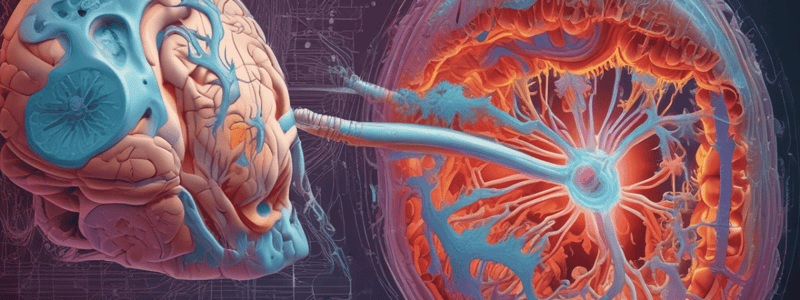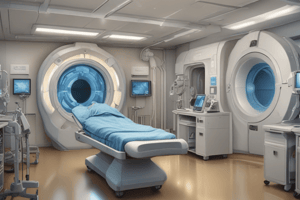Podcast
Questions and Answers
What is the main cause of partial-volume streak artifacts in CT images?
What is the main cause of partial-volume streak artifacts in CT images?
- Detector measurements inconsistency (correct)
- Beam hardening effects
- Shading artifacts
- Beam divergence
Why do small structures like bone pieces sometimes cause image streaks in CT scans?
Why do small structures like bone pieces sometimes cause image streaks in CT scans?
- They are correctly identified by both directions of the beam resulting in inconsistency
- Beam hardening effects lead to their attenuation
- They cause a uniform material to have non-uniform CT numbers
- They attenuate the beam traveling in one direction but are missed by the opposing beam (correct)
What is a common type of shading artifact in CT imaging that often appears near high-density objects?
What is a common type of shading artifact in CT imaging that often appears near high-density objects?
- Beam-hardening effects (correct)
- Scatter radiation effects
- Partial-volume averaging effects
- Spiral/helical scanning artifacts
Which factor contributes to the appearance of shading artifacts near high-density objects in CT scans?
Which factor contributes to the appearance of shading artifacts near high-density objects in CT scans?
How do opposing x-ray beams contribute to partial-volume streak artifacts in CT imaging?
How do opposing x-ray beams contribute to partial-volume streak artifacts in CT imaging?
What effect do small structures, like bone pieces, have on detector measurements during CT scans?
What effect do small structures, like bone pieces, have on detector measurements during CT scans?
What is the primary cause of streak artifacts in CT scans?
What is the primary cause of streak artifacts in CT scans?
Which of the following factors can lead to inconsistent or bad detector measurements, causing streak artifacts?
Which of the following factors can lead to inconsistent or bad detector measurements, causing streak artifacts?
What is the phenomenon illustrated in Figure (2) regarding partial-volume effects?
What is the phenomenon illustrated in Figure (2) regarding partial-volume effects?
What is the effect of beam divergence in CT scans, as mentioned in the text?
What is the effect of beam divergence in CT scans, as mentioned in the text?
Which of the following artifacts is NOT mentioned in the text as one of the three main categories of CT artifacts?
Which of the following artifacts is NOT mentioned in the text as one of the three main categories of CT artifacts?
What is the appearance of shading artifacts, according to the text?
What is the appearance of shading artifacts, according to the text?
Which type of artifact is caused by the projection readings of a single channel or a group of channels consistently deviating from the truth?
Which type of artifact is caused by the projection readings of a single channel or a group of channels consistently deviating from the truth?
What is the primary cause of ring or partial ring (arc) artifacts?
What is the primary cause of ring or partial ring (arc) artifacts?
Which type of CT scanner is most prone to ring or partial ring (arc) artifacts?
Which type of CT scanner is most prone to ring or partial ring (arc) artifacts?
What is the primary cause of shading artifacts in CT scans?
What is the primary cause of shading artifacts in CT scans?
What is the primary cause of streak artifacts in CT scans?
What is the primary cause of streak artifacts in CT scans?
Which type of artifact is caused by the averaging of different tissue types within a single voxel?
Which type of artifact is caused by the averaging of different tissue types within a single voxel?
Flashcards are hidden until you start studying
Study Notes
Streak Artifacts
- Caused by inconsistent measurements of the same ray path due to partial-volume effects, beam divergence, and other factors
- Can appear as intense straight lines across an image
- Factors contributing to inconsistencies include motion, insufficient x-ray intensity, and malfunctions
Partial-Volume Streaks
- Occur when a small structure, such as a bone edge, partially extends into the volume and is detected by one beam direction but missed by the opposing beam
- Results in inconsistent measurements and streak artifacts
Shading Artifacts
- Often appear near objects of high densities
- Caused by beam hardening, partial volume averaging, spiral/helical scanning, scatter radiation, off-focal radiation, and incomplete projections
- Most common type is beam-hardening effects, which appear as non-uniformities in CT numbers of a uniform material
- Can be caused by scatter radiation, although this is uncommon in modern scanners
Beam-Hardening Artifacts
- Present to some extent on all CT images
- Due to imperfect beam-hardening correction
- Appear as non-uniformities in CT numbers, with lower CT numbers at the center of a uniform phantom than at the periphery
Ring Artifacts
- Produced when projection readings of a single channel or group of channels consistently deviate from the truth
- Can be caused by defective detector cells or DAS channels, deficiencies in system calibration, or a sub-optimal image-generation process
- Predominantly a third-generation CT scanner phenomenon
Studying That Suits You
Use AI to generate personalized quizzes and flashcards to suit your learning preferences.




